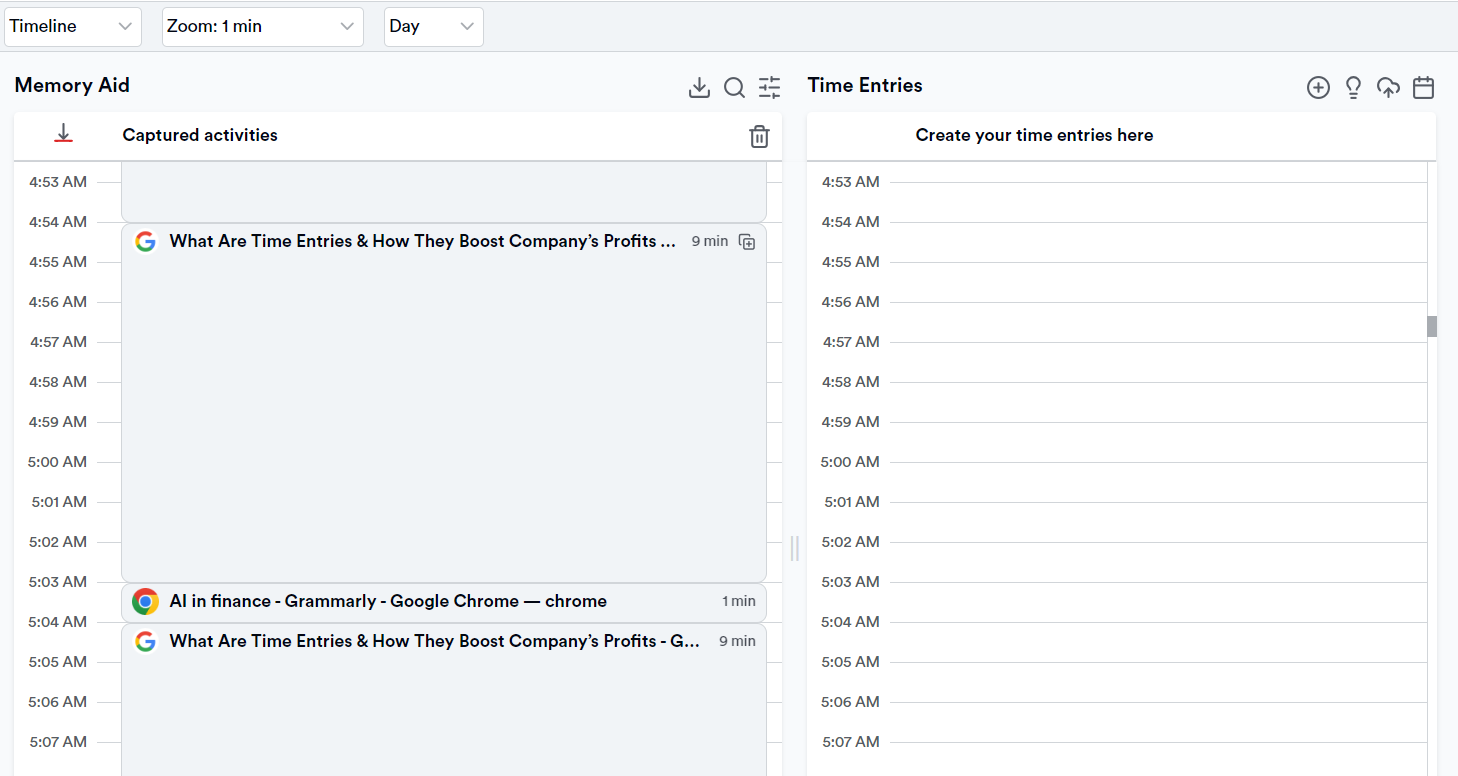What Are Time Entries & How They Boost Company’s Profits

Time entries are there to remind you that the clock is always ticking.
Your “quick coffee break” simply cannot turn into a 45-minute deep conversation on conspiracy theories, such as whether we landed on the Moon or not.
Our time is valuable, yet we all seem to forget its value.
You usually forget about time entries until payday rolls around. And once it’s time you start counting the hours and tasks worked on, you realize you don’t actually know what you worked on yesterday (no surprise there!). Or the day before. Or last Tuesday.
Did you work on a client report? Did you have 2 back-to-back meetings? Who knows.
And here’s the deal: timesheets aren’t just annoying little rows and columns you need to fill out. They’re your (and your business’) weapon for boosting profits and figuring out how all those “quick” 3-minute calls, 10-minute meetings, and 5-minute Slack chats impact your productivity.
So, if tracking your time sounds as thrilling as watching NASA’s totally fake (🤔) Moon landing on a Hollywood soundstage, stick around. You might just discover how these tiny time data pieces can turn your minutes into serious money.
Let’s roll.

What are time entries?
Time entries are documented time slots that depict the duration of the work (tasks and projects) performed.
At their core, they are a way for you and your employees to document where every second of the workday goes, including tracking the minutes spent on client calls, coding the next big app, or scrolling through 9GAG memes.
They act as proof and record of where your employees’ hours actually go—no matter if it’s deep work, endless meetings, or a rabbit hole of research that somehow led them to watch YouTube videos on creative logos and figuring out their hidden meanings.
Time entries usually contain the start and stop times, but one can add additional details, such as the project, task, client, and comment.
Here’s an example of a time entry:
- Time entry title: Research for the Test1 article
- Duration: 0.8h
- Project: Content Writing
- Task: Research
- Client: Memtime
Pros of time entries
Time entries are not yet another admin task.
They are the gateways to increased productivity and profitability because they give you transparency, ensure accurate billing and accountability, and help your business optimize its resources.
Here are a few pros of using time entries:

How to improve time entry accuracy
I know time tracking isn’t exactly the highlight of your own or your employees’ day.
No one wants to remember to log every minute accurately because IT IS an impossible task.
On top of that, time tracking often motivates you (dare I say pressures you?!) to introduce new habits that promise to “make time tracking effortless and precise”. Here are some habits I am referring to:
- You need to remember to log your time as you work, not at the end of the day. If you want to avoid rough estimates, missing hours, and being unable to reconstruct your day, you need to take notes in real time.
- You need to categorize your time entries. You need to break down specific tasks and how long each took, like this: “Client 1: Meeting, 45 minutes”.
- You need to review your time entries at the end of the day (or week). That’s the only way to catch mistakes, adjust any mislogged time, and ensure everything is categorized correctly.
And the worst part is that even if these habits become a part of your time tracking routine, you won’t necessarily increase the accuracy of time entries, as manual time entries are prone to human error, inconsistencies, and missing details.

That’s why introducing an automatic time tracker is the only way to truly improve time entry accuracy.
Memtime: a tool for time entry management
If you are looking for a way to automate your time entries, look no further: Memtime can ensure you create perfectly accurate time entries without lifting a finger. Well, maybe just one finger.
Memtime is an automatic time tracking tool that records how long you spend on different apps, browsers, documents, and tasks— all without manual input. It works in the background, capturing your work activities (tabs, meetings, Slack, Team chats, etc.) so you can review and log them later as time entries, ensuring total accuracy and no more lost minutes or hours.
All you need to do is turn on your computer and start working on tasks and Memtime will capture them all for you.
Here are the most prominent Memtime features:
- Memtime automatically tracks your activity, displaying the program name, details, and the time you spent using it.
- It arranges all your captured activities in a chronological timeline aka the Memory Aid.

- If you want to visualize how your day went, you can zoom in and out and see your work in 1-60 minute intervals.
- Then, you decide which activities to log as time entries (and later assign them to projects and tasks in your project management software).
- Memtime integrates with 100+ tools and apps, providing you with a two-way sync, meaning you can import projects (and tasks) into Memtime and then export time entries back to those projects and software.
- Your data is visible ONLY to you and stored locally offline on your computer. No one has access to it, and you don’t have to worry about potential breaches in cloud storage—there isn’t one.
- Memtime is available for Windows, macOS, and Linux.
- Memtime doesn’t send you annoying notifications and doesn’t remind you to log your idle time or take a pause (like some apps with a Pomodoro timer do). It’s simply there, running in the background, allowing you to work peacefully and forget you’re even tracking time.
- With Memtime, you can recover up to 20% more billable time without working more.
Our app allows you to be 100% sure about your work hours, so you can accurately bill your clients without worrying about undercharging. Your invoices will be precise as a well-calibrated Swiss watch.
It takes less than 10 seconds to create a Memtime account (with just your name, no credit card info needed) so you can download and install the app.
Just click the button below and give automated time tracking a go. It’s on us, 2 weeks free of charge.
How to create time entries with Memtime
Let’s recap. Memtime automatically tracks and captures all your computer activity. Once all your activities are captured, you can create time entries based on them and sync those time entries into your project management software (or Memtime Projects if you don’t use one) under the right projects, tasks, and clients.There are 4 ways to create time entries in Memtime.
#1 A right click on activity
Once you do a right-click on a specific activity, select Transform to Time Entry.


#2 Selecting multiple activities
You can also create time entries for several activities at once. Here’s how you do it:
- Hold Ctrl on Windows or CMD on Mac and click on several activities to select them.
- Right-click on one of the selected activities and choose Create Time Entries for Selection. After that, the tracked information from each activity will be added as a comment within the time entry.

#3 Click’n’drag
The quickest method to transform an activity into a time entry requires clicking and dragging down within the Time Entries column. Memtime will automatically select all recorded activities corresponding to the specified time entry section.

#4 The “+” button
When using this method, all you need to do is click the “+” button at the top of the Time entry column to create a new time entry.

And here’s a step-by-step guide for all the mentioned methods:
Wrapping up
Time entries can be annoying little chores if you don’t automate them.
But they are also your shot at boosting profitability.
If you want to be diligent about time tracking and time entries, try Memtime.
Memtime is your reliable tool that helps you reconstruct any day, any time. Memtime can do the detective work for you, so you don’t have to deal with mysteriously disappearing workdays and spreadsheets that make your head spin.
Allow Memtime to handle it all; sign up for our 14-day free trial now. Your future self (and your paycheck) will thank you. 🙂
Aleksandra Doknic
Aleksandra Doknic is a copywriter and content writer with six years of experience in B2B SaaS and e-commerce marketing. She's a startup enthusiast specializing in topics ranging from technology and gaming to business and finance. Outside of work, Aleksandra can be found walking barefoot in nature, baking muffins, or jotting down poems.






